View the Inspiration Report above or download the PDF version here.
View the Inspiration Report above or download the PDF version here.
How do we find success in the Library and Information Science (LIS) profession? Michael Stephens (2019) presented an equation to help break down the necessary elements:
Essential Skills + Mindset2 × Support = Success
The first element of this equation comes from formal and informal education, including MLIS courses as well as professional and general life experience. While this aspect is just as vital to success as the rest, I found myself reflecting more on both mindset and support as they relate to learning experiences. For me, the former breathes life into practice and the latter provides solid ground from which to continue that practice. So how do we address these ideas?
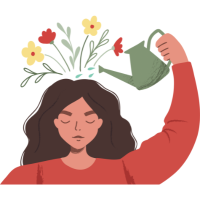 Mindset
MindsetOur approach to the LIS profession must be reflective and intentional. Stephens (2025) connected a series of concepts for what he referred to as soft skills or “❤️ skills”. Many of them resonated with me as ways to focus my mind – and heart – on the work ahead. Through curiosity, creativity, balance, and compassion, we can connect with people, explore deeper, and develop new ideas. I hope I’m not assuming too much by saying that I think most of us are here because we care about and want to help people. This is certainly true for me. However, it can be almost too easy for me to care so much that I end up with a great deal of compassion fatigue and I need time to get back to those ❤️ skills.
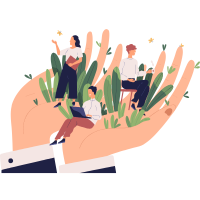 Support
SupportInstitutional leadership can help with professional growth through transparent communication and inclusive management practices. It’s also important that leadership is adaptable and open to new ideas – after all, the success of the staff can mean the success of the organization. This ideal scenario isn’t always reality, though, and the stress and setbacks of navigating professional growth without that support can be overwhelming. Hopefully, as long as we can hold onto our positive mindset, we have the capacity to guide our own professional development. This is where strategic, curious, and skeptical learners can navigate professional learning experiences in their own ways (Stephens, et al., 2021).
The important thing to remember is that we don’t just obtain the skills, mindset, and support to be successful and then move on. We are constantly learning and adapting, for our own knowledge-building and to prepare us to use our learned skills for the people we are committed to serving. Finding ways to continue this work while also maintaining healthy self-care practices is also essential. Professional learning experiences can be found in formal conferences, individual resource exploration, and in partnerships or mentorships with other LIS professionals. Whichever is your preferred method of learning, be curious, be creative, find balance, and greet the world with compassion. Happy learning!
Stephens, M. (2019). Wholehearted librarianship: Finding hope, inspiration, and balance. ALA Editions.
Stephens, M. (2025). [Video lecture on reflective practice.] Retrieved July 24, 2025, from the course site for INFO 287: The Hyperlinked Library at San Jose State University.
Stephens, M., Partridge, H., Davis, K., & Snyder, M. (2021). The strategic, curious & skeptical learner: Australian public librarians and professional learning experiences. Public Library Quarterly.
I love books. I have always loved books. As a kid, I couldn’t stop reading and would get in trouble at school or for staying up past my bedtime. I was shy and had a difficult time finding comfort in building new relationships. Books were my escape into worlds of acceptance and camaraderie.
Then in college, I was flung into depression and I read to avoid facing the pain and numbness of the world. Perhaps because I didn’t have a strong social network behind me, I suffered. I stopped caring about my own wellbeing and simply functioned on autopilot – going through the motions without thought or awareness. But graduation was approaching and I knew I couldn’t survive on autopilot for long. Amazingly, a job opportunity in a high school library popped up immediately. Still deeply enshrouded in mental fog, I pushed myself to apply and interview. I got it.
The librarian at the school was excited for me to start and invited me to tour the library. It was class time and the hallways were quiet, but as we approached the library doors, a student was leaving. It was clear she was ditching, but the librarian graciously introduced us. In the awkwardness of the situation, the student was flustered and barely managed to greet me.
That was the moment.
It wasn’t about me anymore. I needed to start caring again. For her. I was awkward and I knew that feeling of being caught doing something you weren’t supposed to do. I was only a few years older and barely had any more life experience, but I wanted to be part of a support system that I had lacked. These teenagers were just trying to find themselves and their place in the world. And I wanted to help them.
This is my story, at least in part. So I ask you now, can you relate to it?
Did you read as much as I did?
Have you experienced mental health concerns?
Have you overcome mental obstacles?
Have you found what you want to do with your life?
Even if you can’t answer any of these questions, maybe you at least know me a little better. A small connection that can transform into a vast network of stories. Hopefully we can start to share a narrative, build empathy, listen to each other, and begin to understand the WHY.

Storytelling components for impact (Library 2.0, 2020).
Storytelling is a powerful tool for personal growth, getting to know a community, and creating an impactful library. Understanding why we’re here and why people come to the library will not only inform potential programming and services, but it can also communicate value to library funders (Library 2.0, 2020). Additionally, breaking down barriers between each other involves self-reflection, and being supportive means more than just acceptance – it requires action (Arne-Skidmore, 2021). Behavioral changes, leadership changes, or programming changes can make a huge difference in connecting with people.
Here are a couple examples of inclusive action through storytelling:
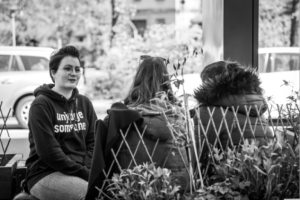
Reading Garden (Human Library, n.d.).
The Human Library – This program offers readers a chance to check out “human books” and have a conversation with someone who has a particular perspective or life experience. By asking questions, engaging with new ideas, and finding shared understanding, individuals and communities are brought together (Wentz, 2013).
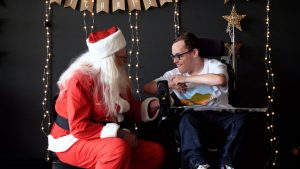
Sensitive Santa (Yarra Libraries, 2022).
Sensitive Santa – This program is an alternative to a shopping center Santa experience for neuro-divergent children. A sensory-friendly environment with staff and a Santa who know each family’s needs provide a space for kids to connect without feeling overwhelmed (Library 2.0, 2020).
Finally, I leave you with a small reminder to be genuine and present. Michael Stephens (2019) shared a tip for fellow presenters, but I think it can also be applied to our interactions with each other and our communities:
“Be yourself, share your story honestly, and your audience will be right there with you.”
References
Arne-Skidmore, E. (2021, August 4). New study on the impact of the Human Library. Human Library.
Human Library. (n.d.). Human Library Reading Garden.
Library 2.0. (2020, March 11). The power of stories [Video]. YouTube.
Stephens, M. (2019). Office hours: With a little twist & power of the pod. INFO 287 – The Hyperlinked Library.
Wentz, E. (2013, April 26). The Human Library: Sharing the community with itself. Public Libraries Online.
Yarra Libraries. (2022, December 22). Sensitive Santa | Yarra Libraries 2022 [Video]. YouTube.
I would love to explore the idea of meeting people where they are. I have applied this idea in the past by considering the mental, emotional, or developmental space patrons may be in and by gearing library materials and services to better serve them. However, I admit I don’t always think about a patron’s physical space. If a patron isn’t physically in the library, how can I help them? Perhaps by providing online options, or… – and this seems obvious now – GO TO THEM!
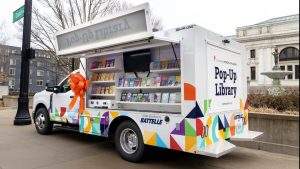 Popup Library (10TV, 2025). |
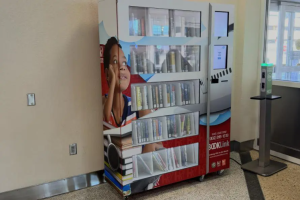 Library Kiosk (Zuvanich, 2023). |
Services like bookmobiles, pop-up libraries, little free libraries, and other similar options can provide different forms of support for patrons who are remote or unable to get to their main local library. Additionally, nonusers of the library probably don’t even realize what they’re missing! It would be great to design ways for anyone and everyone to interact with library services and resources no matter if they come to the library or not. This can be an important aspect of building social infrastructure and inclusion, which Eric Klinenberg addresses as promoting civic cohesion (Gaetani, 2018).
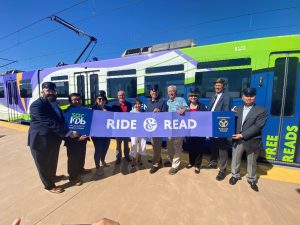
Rolling Library (SPL, 2022)
One example of bringing library resources to the public where they are is the Rolling Library Train in Sacramento (Sacramento Public Library, 2022). Doubling as public transport and a library, this train features QR codes offering downloadable materials and access to library resources while users commute to their various destinations. Through collaboration and innovation, this service removes barriers to literacy and lifelong learning as well as encourages the use of public transport over driving.
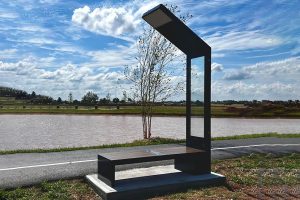
Library bench (Furbee, 2023).
Another innovative idea to connect with people where they are is the installation of solar-powered benches in the community, as was done by the Pioneer Library System in Oklahoma (Furbee, 2023). These high-tech benches offer free Wi-Fi, charging stations, and QR codes to access library materials. Originally installed to bridge the digital divide during COVID-19, they also support tourists and patrons while they’re out and about or just passing by.
Through strong partnerships with city officials, models for meeting people where they are in their day-to-day environments can be achieved. While working with the Friends group for my local library, a member of the public responded to our promotion efforts with, “Oh, I love the library! I didn’t know there was one in this town. Where is it?” “Right across the street!” we replied. So easily the little building was overlooked and forgotten. All the more reason to create access points for everyone, no matter where they are!
References
10TV Web Staff. (2025, February 15). Columbus Metropolitan Library introduces pop-up library truck. 10 WBNS.
Furbee, B. (2023, May 1). Sit and Surf. American Libraries Magazine.
Gaetani, M. (2018, November 11). Q&A with Eric Klinenberg. Stanford University.
Sacramento Public Library. (2022, August 31). Read and ride on the new Sacramento Rolling Library Train. Sacramento Regional Transit.
Zuvanich, A. (2023, November 27). Houston Public Library launches self-service book kiosk at Hobby Airport. Houston Public Media.
Add a Multimedia Studio space to the Mack High School Library for academic and personal creative learning experiences. Trained staff will be available for programs and in-person or virtual guided workshops. The studio will be open to students, teachers, and staff at MHS and will be designed for HOMAGO – a space where students can Hang Out together, Mess Around with the technology, and Geek Out by creating original content (Yollocalli Arts Reach, 2013).
The studio will include:
Users will be able to:
MHS is a small high school in a rural area. The school district’s Local Control Accountability Plan reports that over 43% of students are socio-economically disadvantaged and in need of additional academic support (NHUHSD, 2025). Concerns include declining academic motivation and school connectedness. Goals were set to create community-building activities where students can meaningfully participate and to develop project-based learning that involves student voice and choice.
Implementing a Multimedia Studio in the school library aids district goals. Students can actively design the space and use it to learn new skills. This is especially important for students who would not otherwise have access to technology or guided learning opportunities. The studio will connect them to the school as well as allow them to make connections to future aspirations.
Goal I: Increase digital literacy skills through creative exploration.
Objective 1: Integrate digital tools into library programming.
In an effort to connect students with their school and develop a greater sense of belonging, the technology, space, and workshops will be integrated into an existing community space. Students will help design and choose the elements that are the most important and of interest to them to help prepare them for future college and career aspirations.
Objective 2: Promote inclusive and equitable access to technology.
To bridge the digital divide in the community, access to the studio’s technology will be made available during various hours of the day. Additionally, trained staff will be onsite to aid students as well as to run guided learning workshops.
Goal II: Minimize learning loss through creative engagement.
Objective 1: Encourage student-led exploration.
In order to create a method for meaningful participation by students, they will lead the growth of the studio project. Programs and workshops will be designed based on student request and input, and peer-to-peer tutoring and engagement will be encouraged.
Objective 2: Develop interdisciplinary learning opportunities.
To support the academic achievements of students, collaboration with teachers and staff will create avenues for project-based learning that can connect to real world applications.
A Multimedia Studio will align with district, school, and library mission statements by supporting students’ personal and academic growth and by providing resources to encourage lifelong learning. This can lead to a successful integration of a new technological service while not overwhelming staff (Stephens, 2004).
The school district will… “provide the highest quality, comprehensive education in a safe, supportive environment, by promoting a culture of academic excellence, innovation and creativity; ensuring an outstanding, passionate staff committed to student achievement; encouraging acceptance of and appreciation for diversity; and offering a wide range of curricular and extracurricular activities for all students” (NHUHSD, n.d.).
The school site will… “foster an inclusive community where all individuals can excel both personally and academically by empowering learners with meaningful skills in a safe and supportive environment” (MHS, n.d.-a).
The school library will… “provide access to current, adequate and appropriate information resources and ensure that all students and staff members are effective users of ideas and information” (MHS, n.d.-b).
Convince high school students at MHS
…that by: using the Multimedia Studio in their library
…they will: learn new skills and create new content
…which will: help them with class assignments and add to their skill sets and resumés,
…because: through creativity and digital literacy they can be confident and successful in future academics & careers.
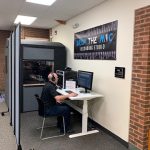 Charles County Public Library |
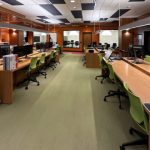 Fountaindale Public Library District |
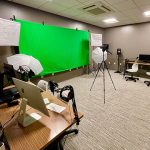 Martin Public Library |
 Topeka & Shawnee County Public Library |
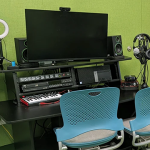 Wichita Public Library |
Fall – Define Goals
Winter – Inform Users
Spring – Get Feedback
Summer – Install & Train
Fall – Use & Evaluate
Library and IT staff are tasked with student, facility, and equipment safety and so will be the ones to create policies that align with school rules and guidelines.
Multimedia Studio Policies
The Multimedia Studio will be promoted through various channels including in person announcements, visual displays, and collaborative efforts. Communications by students, for students will be emphasized through student-led social media posts and videos.
On Campus
Off Campus & Online
Library staff will receive training for the use of equipment and technology as well as the necessary software. This will be aided by IT staff or by outside professional development opportunities.
The library can then offer workshops for students, teachers, and staff to learn new skills. These may be in-person or created as online and asynchronous tutorials. As new ideas emerge through participation and exploration, additional training may be undertaken collaboratively.
Evaluation will be based on both observed use by library staff and anecdotal feedback. Students sharing their original content for library displays or school social media posts as well as for projects submitted as class assignments will inform library staff and administration of use. Student and staff feedback about the studio’s limitations or possibilities for additional equipment will be valuable in assessing future adaptations. Though technology will continually be evolving and library staff should be open to any changes, the needs and interests of the students (and budget restrictions) will determine how and to what extent the Multimedia Studio will expand (Stephens, 2019).
Casey, M. & Stephens, M. (2008, April 15). Measuring progress. Tame the Web.
Charles County Public Library. (n.d.). Drop the Mic Recording Studio.
Fountaindale Public Library. (n.d.). Studio 300.
Martin Public Library. (n.d.). Sound and Video Recording Studio.
McKinleyville High School. (n.d.-a). Our vision.
McKinleyville High School. (n.d.-b). Welcome to the library!
Northern Humboldt Union High School District. (n.d.). Vision, mission and goals.
Northern Humboldt Union High School District. (2025). LCAP.
San Francisco Public Library. (2024). Vision 2030: San Francisco Public Library strategic plan: 2024-2030.
Stephens, M. (2004, November 1). Technoplans vs. technolust. Tame the Web.
Stephens, M. (2019). Wholehearted librarianship: Finding hope, inspiration, and balance. ALA Editions.
Topeka & Shawnee County Public Library. (n.d.). Level 2 Tech Center.
Wichita Public Library. (n.d.). AV Studio.
Yollocalli Arts Reach. (2013, February 13). HOMAGO guidebook. Issuu.
I appreciate the efforts being made to incorporate diverse cultures into library settings and services, particularly the values and customs of local Indigenous communities. Creating respectful and inclusive spaces is such an important aspect of meeting a community’s needs and developing a place of trust. According to the National and State Libraries of Australasia, a culturally safe library is an environment “where people feel supported, can express themselves and their culture, history and identity with dignity and pride” (NSLA, n.d.). Making a change in this direction can open the doors to people who may have previously felt invisible or unwelcome.
Information organizations have existed for so long, creating ways of organizing and disseminating knowledge and providing outreach for the community. Over time, it may be easy to accept the traditional methods and not consider any institutional changes to reflect ongoing changes in the community. It is important to stay connected and to identify the cultural values of the people being served to respectfully engage and honor them.
I work in a school with an Indian Education Program that offers language classes, club activities, cultural events, and support for Indigenous students (Indian Education Program, n.d.). Over the last few years, effort has been put into integrating language and culture into day-to-day school life. All around campus, including the library, posters and communications that have English and Spanish now also include Yurok – a local Indigenous language that was nearly extinct until it was offered as a class 25+ years ago. Collaborative efforts have also increased the number of events and activities for the entire student body, allowing Indigenous students and families to share their stories and customs while building self-esteem.
Other examples of Indigenous inclusion
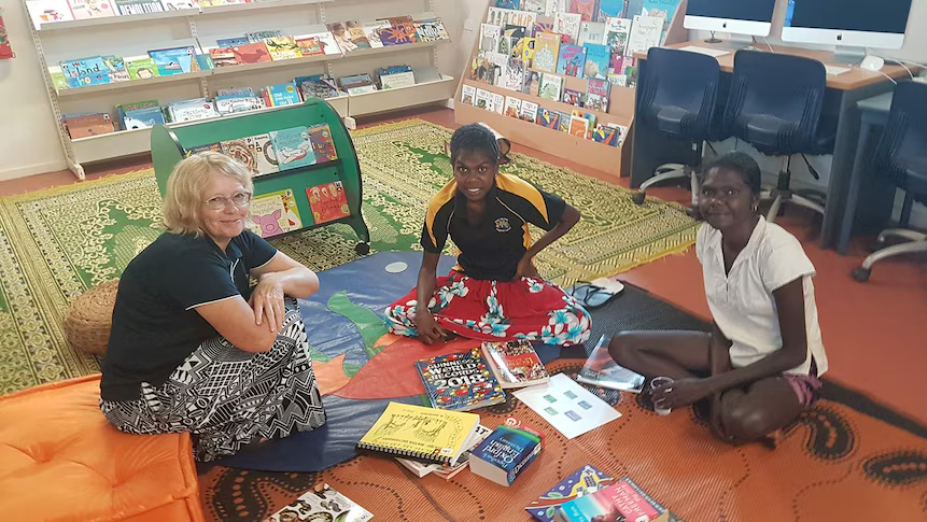
In Galiwin’ku, a remote community in northern Australia, the library chose to do away with the Dewey Decimal system (Thompson & Trevaskis, 2018). The organization of books made little sense to the users of the space so a more culturally-centered method of organization was implemented. By grouping books according to local community values and interests, library users felt validated and were more empowered to use the space.
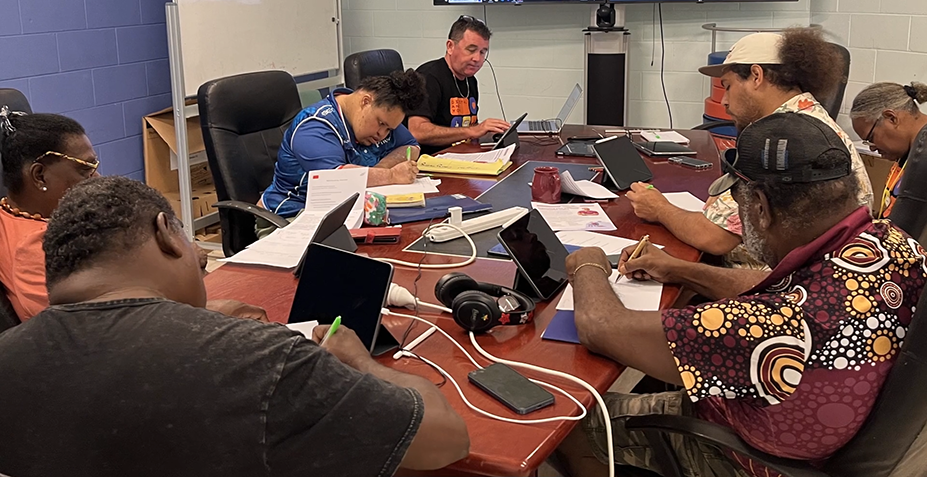
The Indigenous Knowledge Centre on Mua Island in northern Australia, offered free digital workshops for their local community (Reynolds, 2025). Not only did this program allow people to share their stories and artwork, it also gave them an opportunity to learn new digital skills and apply creativity to these learning experiences. The participatory environment provided users a space to gather, create, share, and learn together.
Indian Education Program. (n.d.). Brief History of Indian Ed Title VI in CA. Northern Humboldt Union High School District.
National and State Libraries of Australasia. (n.d.). Culturally safe libraries: Working with Indigenous collections.
Reynolds, M. (2025, March 24). Digital skills spark new creative ideas in Arkai (Kubin) on Mua Island. State Library of Queensland.
Thompson, J. & Trevaskis, L. (2018, August 21). Galiwin’ku library closes book on the Dewey Decimal System to prioritise Yolngu culture. ABC News.
I have been drawn to the issue of accessibility – not just making services accessible on site and online, but also accessible to remote patrons. Bookmobiles are one example of reaching the communities who are too far from and/or are unable to transport themselves to the nearest library. Without solutions like this, remote communities easily become non-users of the library, and then the question arises: are their needs being met?
Libraries strive to support and engage their communities to create a strong and open society. Programs and services are designed to meet specific needs identified in these communities and statistics focus on the number of circulations or program attendance. Unfortunately, community-centered services can leave out remote patrons. This exclusion of part of the population can be extremely detrimental. As Lauersen (2018) noted, “inclusion makes you thrive mentally and physically, gives us the opportunity to learn from others and to help others and it can help us feel that we belong.”
In my own location, 47.6% of the population live in the largest cities, leaving most of the population spread out in rural, and often remote, areas (HCOE, n.d.). The bookmobile that serves some of those remote communities offers books and other library materials that can be browsed or requested ahead of time, prizes for kids, participation in the Summer Reading Program, and a knowledgeable librarian to answer questions and help connect people with resources (Humboldt County Library, n.d.).
Rural areas are less likely to have consistent internet access, making online services difficult or impossible to use (Swan et al., 2013). Mobile solutions, like bookmobiles, are a great strategy for bridging the gap. Resources and opportunities delivered to remote patrons allow them to connect with needed information and remain an inclusive part of the community. From finding details on housing and job opportunities to engaging the imagination with mobile storytimes, on-the-go library services can make a huge difference in the lives of people who could otherwise struggle without this kind of support. Traditional services as well as technological services delivered to remote areas can build stronger communities outward.
Examples of services for remote patrons
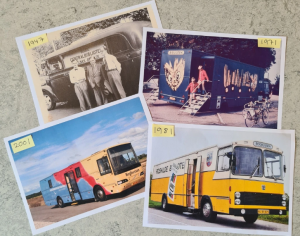
Lauersen, 2025.
Lauersen (2025) reported on a Danish bookmobile that brought together people of small village communities. He noted that this service not only engaged the community with library resources, but also served to combat isolation and improve societal welfare. Investing in library services that can make strong connections such as this is necessary through collaboration between information organizations and the people they serve.
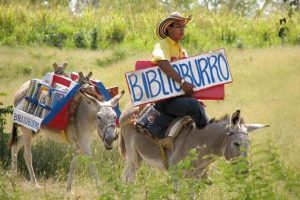
FELA, 2014.
In Northern Colombia, a “Biblioburros” – a mobile library carried on the backs of two donkeys – visits remote farming communities (Rocketboom, 2009). The schoolteacher who runs the program from his home is committed to providing books and personal connection for children. This service supports literacy, lifelong learning, and empowerment for those who would otherwise be without.
Federation of European Literacy Associations. (2014, May, 14). [Photograph of the Biblioburro in Colombia].
Humboldt County Library. (n.d.). Bookmobile. Humboldt County.
Humboldt County Library – Eureka Main Branch. (2025, May 10). [Photograph of a bookmobile parked on the side of a remote, rainy road]. Facebook.
Humboldt County Office of Education. (n.d.). Fast facts.
Lauersen, C. (2018, June 7). Do you want to dance? Inclusion and belonging in libraries and beyond. The Library Lab.
Lauersen, C. (2025, February 5). The necessary nearness – an ode to bookmobiles. The Library Lab.
Muddy River News. (2025, April 25). Book nook: To the bookmobile! [Video]. YouTube.
Quincy Public Library. (n.d.). Mobile library.
Rocketboom. (2009, September 30). Library on a donkey [Video]. YouTube.
Swan, D. W., Grimes, J., & Owens, T. (2013, September). The state of small and rural libraries in the United States. Institute of Museum and Library Services.
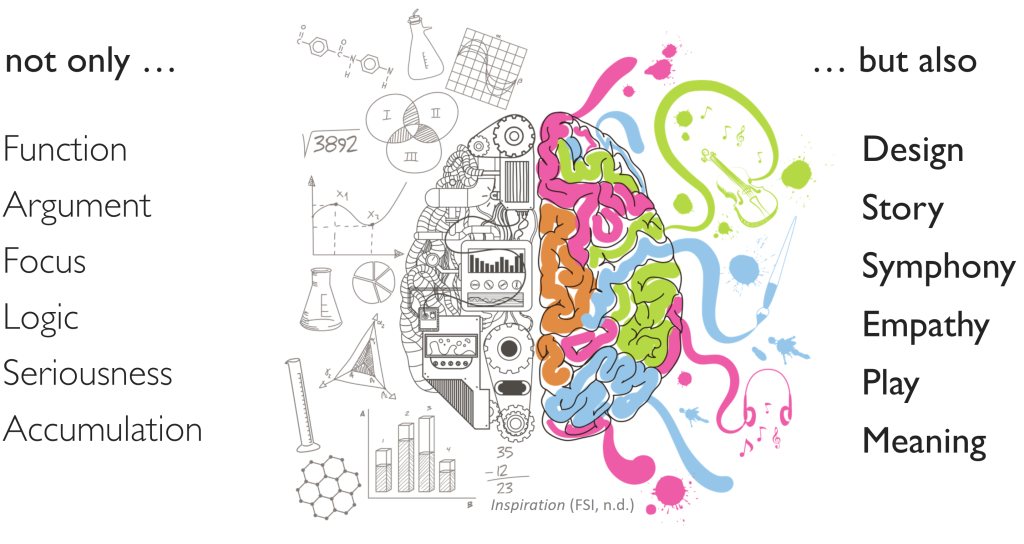
These six words were introduced in the lecture on the Hyperlinked Library Model (Stephens, 2025) to describe the creative senses needed to guide and shape the world. I was drawn to the simplicity of how the concepts were displayed, reduced to singular and powerful words. I spent a few moments reflecting on each as well as their combinations. Later in the lecture, another word caught my attention. Instead of aligning with my perception of the library field, it challenged me. I generally use this seventh word in a negative manner, but within the Hyperlinked Library Model it is to be embraced.
So what do these words mean in the context of hyperlinked libraries?
My first thought is space – physical and virtual – and the design of spaces that help connect people to resources and each other. The original author of the six senses, Daniel Pink, described design as a blend of aesthetics and functionality (Roy, 2006). Additionally, Skot-Hansen (2017) discussed the Four-Space Model used in Danish libraries to foster information sharing and experience. By creating separate and overlapping spaces with different purposes, connections develop through experience, empowerment, involvement, and innovation.
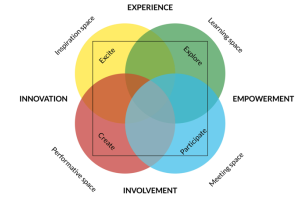
The Four-Space Model (Skot-Hansen, 2017)
Every individual has their own story that colors their interactions with the world. Beyond books that tell us tales of real and imagined people, libraries not only curate collections, but create new ways of collecting, making, and sharing stories. In Wholehearted Librarianship, Stephens (2019) discussed several examples of this work, from podcasts to live and recorded storytelling events. The common factor was building connections in the community – unique experiences connecting to a shared humanity.

Another example: Language Café at DOK
Music can be made up of many different elements, whether they’re instruments, melodies, or percussions. What matters is that they all create unique sounds to make a harmonious whole. This is the core idea behind participatory culture – people do not just consume information and media, they create and share it, too. For example, Boekesteijn (2011) discussed a multitouch table at DOK in the Netherlands where visitors could engage with and contribute to community conversations.
As librarians – as humans – we cannot help each other if we cannot understand or connect with one another. In The Heart of Librarianship, Stephens (2016) discussed empathy as an important factor in engaging with people. The more kindness and understanding we exercise, the more welcome and comfortable people will be when seeking resources and participating in activities. This cultivates trust and respect and allows for user-centered thinking and collaboration.

Unquiet Library (Hamilton, 2010)
I think of programs offered at my local library providing opportunities for fun and play. Douglas Thomas and John Seely Brown described play as “the basis for cultivating imagination and innovation” (Stephens, 2025, 10:50). Play is linked to lifelong learning through experimentation and iteration without worry of real world consequences. Mathews (2010) discussed a high school’s “Unquiet Library” offering a variety of spaces, activities, and learning opportunities. Students took pride in their library where they found enriching educational and social experiences.
My first thought is purpose and significance – the impact something can have in creating relevance. Relatedly, Stephens (2025) described meaning as the “context to life”. Through authentic connections with people, resources, and services, that meaning can be appreciated. Mattern (2014) discussed the library as social infrastructure, noting that libraries reach a variety of people, including children, seniors, immigrants, and entrepreneurs. Communities form around diverse needs and libraries work to meet them where they are.
Disorganized. Frustrating. Out of control. These can be bad things in my mind, but that doesn’t mean avoidance is any better. The key message here is that chaos comes from change when we are not prepared for it. However, change is necessary to meet a constantly changing world. As Michael Stephens put it, “Hyperlinked library services are born from the constant, positive, and purposeful adaptation to change that is based on thoughtful planning and grounded in the mission of libraries” (2025, 35:28).
These six senses weave together and make it difficult to address them singularly. And chaos? Perhaps it isn’t a sense, but it is a piece of the ever-evolving landscape of the library field. As information professionals, we must embrace change to incorporate these concepts into our work. Chaos will be inevitable, but the more flexible we can be with change, the easier the experience of chaos will be.
I work in a high school library and last week was the end of the school year. I ordinarily associate the last week with chaos – teenagers procrastinate returning their materials and forget what they’ve checked out since August, and I dread the rush of panic and questions. This year, we planned ahead. Without realizing it until now, we were incorporating these concepts into our plan by designing an open physical space (design), connecting with teachers for open communication (symphony), and allowing time to connect with students individually (empathy). It was a success! I will most definitely keep these six senses in my back pocket to use in future work and in my day-to-day life.
Boekesteijn, E. (2011, February 15). DOK Delft takes user generated content to the next level. Tame the Web.
FSI. (n.d.). Inspiration.
Hamilton, B. (2010, March 10). February 2010 Monthly Report The Unquiet Library. SlideShare.
Mathews, B. (2010, June 21). Unquiet library has high-schoolers geeked. American Libraries Magazine.
Mattern, S. (2014, June). Library as infrastructure. Places Journal.
Roy, S. (2006, March). A whole new mind: Daniel Pink’s engaging book addresses the keys to success in a creativity-driven economy. DDI: Display & Design Ideas, 18(3).
Skot-Hansen, D. (2017, August). Library development: From collection to connection. University of Copenhagen, Faculty of Humanities.
Stephens, M. (2016). The heart of librarianship: Attentive, positive, and purposeful change. ALA Editions.
Stephens, M. (2019). Wholehearted librarianship: Finding hope, inspiration, and balance. ALA Editions.
Stephens, M. (2025). [Video lecture on The Hyperlinked Library Model.] Retrieved June 10, 2025, from the course site for INFO 287: The Hyperlinked Library at San Jose State University.
Imagine a lone, rectangular, temporary building sitting in a patch of flat grassy terrain. On one side, you walk up a few metal steps, passing under big, blocky purple letters that you can’t make sense of this close up, but from far away you know it spells L I B R A R Y. As you pass through the doorway, the entire outside world disappears – only this space exists. It’s one room encircled with low shelves and filled to the brim with every colorful picture and story you can think up – and plenty you can’t until you discover them for yourself. Shelving divides the space, creating nooks for tables and chairs. You could sit here all day, getting up only to find new adventures in different pages, and share your discoveries with the friends who entered this magical space with you.
My first memory of a library was the one in my elementary school. It was small, but I imagine that the tables and chairs in it are also quite small to my now adult-sized body and perception of the world. No matter. I was hooked. For me, the library became the coziest, the most fun, the most relaxing, the most exhilarating, the safest, and the most memorable place to be – a place to hang out with friends, play games, do homework, escape life’s stresses, and whatever else I needed it to be.
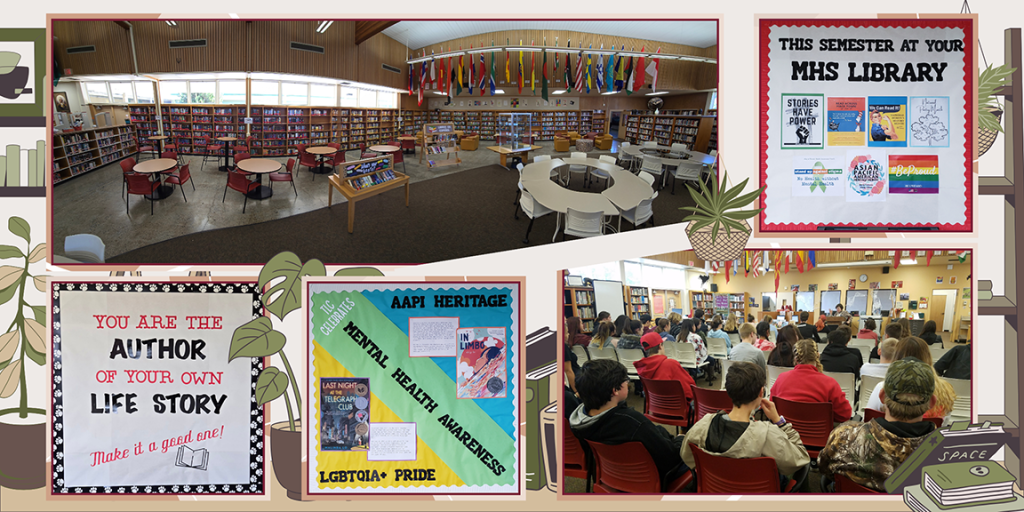
I’ve been a high school Library Aide in coastal Northern California for 13 years now. My favorite part of my current role is being creative and getting to help students and teachers solve problems. I also get to help organize fun events for students, like author visits, reading to kids in local elementary schools, and poetry workshops. I love what I do, but I also want to branch out and explore other avenues which is why I’m now in the MLIS program. Being a student again has been an incredible experience. I’ve found a particular love of information organization, but even so, I’m unsure of where I’ll end up. All I know is that adventure awaits!
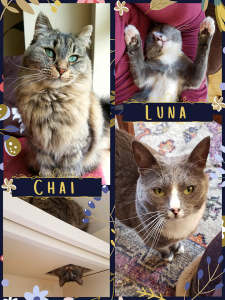
Outside of work and school, I’m quite a homebody. I love staying cozy inside with my two cats, Chai and Luna – my precious and spoiled fur-babies. I enjoy big mugs of tea, jigsaw puzzles, and video games. I usually stick to cozy games like Stardew Valley and I just recently finished (several) playthroughs of Pentiment, a wonderful and stylistic historical mystery game. I’m adding to my list and collecting TBR books faster than I can read them, by far, but that doesn’t stop me from taking more suggestions! I’m currently reading Foundryside by Robert Jackson Bennett which is the start of a fantasy series with an interesting take on magic systems. Somehow, the way the world and magic interactions are described comes across like a science fiction read. So far so good, but I hear book two is even better!
If I do happen to venture out into the world, it’s usually to go horseback riding, to visit with family, or to walk along the beach or in the redwoods. Although I don’t have my own horses, I’ve been riding at a local farm for over 20 years which has become something of a second home to me. I’m also lucky to have some of my family living locally and we make a point to spend time with each other, even making little trips to hike through nature.
If I venture out even further, it’s to travel around California and up into the Pacific Northwest. I also hope to travel abroad again as I would love to return to Europe to revisit the UK and Ireland. My next trip, however (perhaps after graduation), will hopefully be to explore Spain and Portugal, discover Scandinavia, or so many other dream destinations.
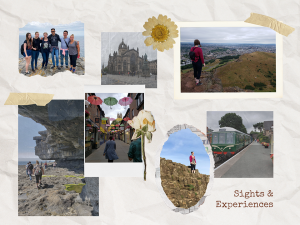
I have so much gratitude for all the lovely things in my life. It’s not always sunshine and rainbows and sometimes I have to look for these genuine and full-hearted moments to pull me through the tough parts. I’m lucky to have so much to hold on to, including being a student and having the opportunity to learn so much more. Here’s to another great semester!
© 2025 StorySpark
Theme by Anders Noren — Up ↑